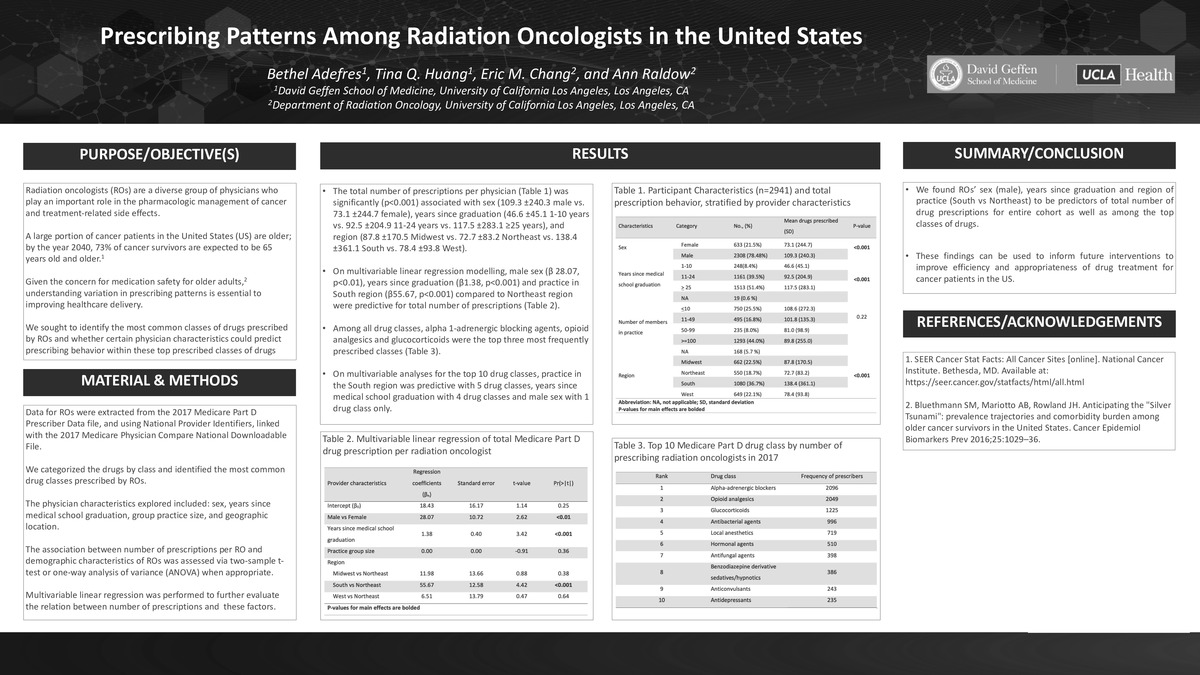-
Author
Bethel Adefres -
Co-author
Tina Q. Huang BA, Eric M. Chang MD, Ann Raldow MD
-
Title
Prescribing Patterns Among Radiation Oncologists in the United States
-
Abstract
Prescribing Patterns Among Radiation Oncologists in the United States
Purpose: Radiation oncologists (ROs) are a diverse group of physicians who play an important role in the pharmacologic management of cancer and treatment-related side effects. However, their prescribing patterns remain poorly described. We sought to identify the most common classes of drugs prescribed by ROs, and whether certain physician characteristics could predict prescribing behavior within these top prescribed classes of drugs.
Methods: Data for ROs were extracted from the 2017 Medicare Part D Prescriber Data file, and using National Provider Identifiers, cross linked with the 2017 Medicare Physician Compare National Downloadable File. We categorized the drugs by class and identified the most common classes of drugs prescribed by ROs. The physician characteristics we explored included: gender, years since graduation, group practice size, and geographic location. Association between various RO practice characteristics and prescribing behavior was summarized and formally tested using the two-sample t-test and one-way analysis of variance (ANOVA). Multivariable linear regression was performed to identify factors independently related with the number of prescriptions.
Results: Of the 2941 ROs identified, 2308 (78.5%) were male and 633 (21.5%) were female. The total number of prescriptions per physician was significantly (p<0.001) associated with gender (109.3 ±240.3 male vs. 73.1 ±244.7 female), years since graduation (46.6 ±45.1 1-10 years vs. 92.5 ±204.9 11-24 years vs. 117.5 ±283.1 ≥25 years), and region (87.8 ±170.5 Midwest vs. 72.7 ±83.2 Northeast vs. 138.4 ±361.1 South vs. 78.4 ±93.8 West). On multivariable linear regression modelling, male (β28.07, p<0.01), years since graduation (β1.38, p<0.001) and South region (β55.67, p<0.001) compared to Northeast region were predictive for total number of prescriptions. Among all drug classes, opioids, alpha-adrenergic blockers and steroids were the most commonly prescribed classes (Table). On multivariable analyses for the top 10 prescribed drug classes, years since graduation was predictive with 5 drug classes (opioids, alpha-adrenergic blockers, antibiotics, local anesthetics and benzodiazepines), gender was predictive with 1 drug class (alpha-adrenergic blockers) and practice location in the South (vs Northeast) was predictive with 4 drug classes (opioid, alpha-adrenergic blockers, steroids and hormonal therapy).
Conclusion: We found ROs’ gender (male), years since graduation and region of practice (South) to be most predictive of higher overall total prescriptions. These factors are also predictive among the top classes of drugs.
-
College
AAC
-
Zoom
https://ucla.zoom.us/j/92557881136?pwd=aE1Gam4zN3RKTHRRRndIQWxVM3IxUT09
-
PDF

